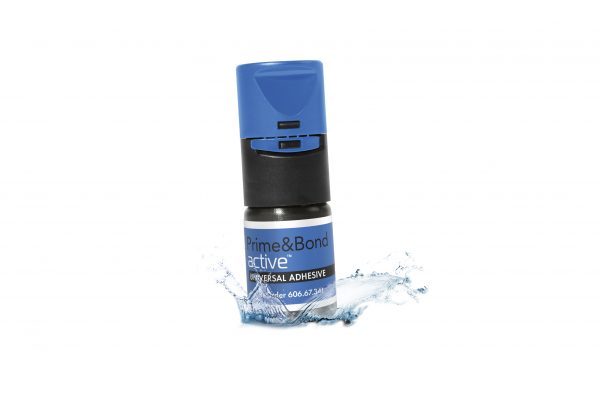Dr Aly Virani and Dr Franco Vittorio relate their experiences with Dentsply Sirona’s new universal adhesive, Prime & Bond active, and explain why for the foreseeable future, they’re sticking with it
 It’s called ‘active’ because it uses a completely new chemistry; a cross-linker that creates a solution of very low viscosity, which makes it easy to apply and gives it the ability to self-spread. Prime & Bond active also has hydrophobic and hydrophilic properties which ensure complete coverage and penetration at varying moisture levels. It is universal, and works with all etching methods and across all direct and indirect indications.
It’s called ‘active’ because it uses a completely new chemistry; a cross-linker that creates a solution of very low viscosity, which makes it easy to apply and gives it the ability to self-spread. Prime & Bond active also has hydrophobic and hydrophilic properties which ensure complete coverage and penetration at varying moisture levels. It is universal, and works with all etching methods and across all direct and indirect indications.
The evidence from Denstply Sirona’s own research and development laboratory tests in Konstanz, Germany and from tests conducted by Professor Andre Reis, assistant professor in the department of operative dentistry at Guarulhos University Brazil, showed that Prime & Bond active performed better in terms of bond strength on both over-wet and over-dry dentine and in terms of coverage thanks to its lower film thickness.
Armed with this compelling evidence and a handful of samples, Dr Virani and Dr Franco agreed to trial Prime & Bond active in their clinical practice.
What made you decide to test Prime & Bond active?
Dr Virani: ‘Seeing the research made me want to give this new universal adhesive a try. With class II restorations, two of the biggest challenges are moisture control and ensuring complete coverage of the surface. The clinical evidence seems to suggest that this new product could help with both.’
Dr Franco: ‘I am a specialist in endodontics so my use of bonding agents is limited to rebuilding the tooth before or after endodontic treatment and I do a limited number of fillings. After being presented with the clinical evidence, especially regarding moisture control and ease of application, I was happy to give it a try.’
What is your opinion of Prime & Bond active now you have used it?
Dr Virani: ‘The main advantage I’ve noticed so far is the easier handling. I find it a lot more ‘forgiving’ as it seems to spread itself more easily and evenly, which helps particularly when access is difficult. For instance, for distal surfaces of molars in class II restorations, when the rubber dam and Palodent V3 system is on the tooth and there’s a rubber dam clamp in the way, it can be awkward to ensure coverage. I feel confident that Prime & Bond active has the ability to get in all the nooks and crannies.
‘If it’s as forgiving with moisture control as the research suggests, this will help with my cementation protocol for porcelain work and class II restorations. When I’m working with a deep cavity and slightly sub-gingivally, it’s often a struggle to get a rubber dam at the gingival margin. I know there’s going to be a certain amount of moisture present and using a bonding agent which can handle higher levels of moisture that will ensure a strong bond, will give me peace of mind. Having worked with Prime & Bond active for only four months, it’s too early to tell whether using it has improved my long-term outcomes, but results are good so far and I’m hoping to see a difference in terms of a decrease in debonding in the longer term.’
Dr Franco: ‘In my opinion, Prime & Bond active is a wonderful product for use with vital teeth due to its easy handling and the elimination of any influence from the clinician. It is really easy to put the bond onto the tooth and after a wait of only 20 seconds, you have good adhesion without post-operative sensitivities. For endodontics, it is enormously helpful to have an adhesive that is easy to brush on – particularly in the face of difficulties we often have to overcome in isolating the teeth and applying the rubber dam. It makes the adhesive application step very straightforward and, I believe, is better than other material on the market, including the earlier Prime & Bond.
‘I save time using Prime & Bond active too; it isn’t necessary to etch the dentine of the tooth after a root filling so I can go straight ahead and add a very thin layer of bonding material. It also doesn’t matter how wet the dentine is, which is very helpful when inserting a post or working in a deep cavity where it’s not easy to manage humidity or control moisture.’
Based on your experience so far, are you planning to use Prime & Bond active for all your future bonding needs?
Dr Virani: ‘I didn’t move to Prime & Bond active because I was having trouble with other bonding agents – to be honest, I haven’t had any problems with postoperative sensitivity or debonding. I have changed because I really liked the sound of this new product and all the benefits make perfect sense to me as a clinician. Even without the longer-term evidence of its efficacy, I am already a convert and intend to continue using it for all my bonding requirements.’
Dr Franco: ‘I’ve been working with this new adhesive for a year and a half, so it’s too early to be able to judge the long-term results in terms of post dislodgement. However, based on my clinical experience so far, including the superior handling and absence of postoperative sensitivity, I am going to stick with Prime & Bond active for the foreseeable future.’
To find out more about the extensive range of class II restoration solutions, materials and equipment, visit www.dentsplysirona.com.


